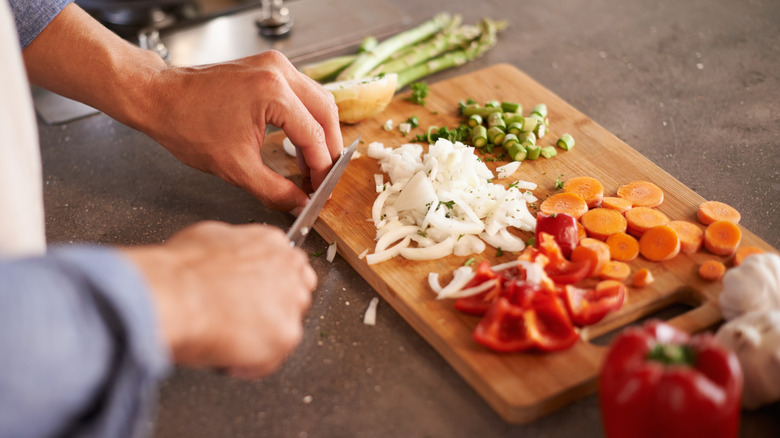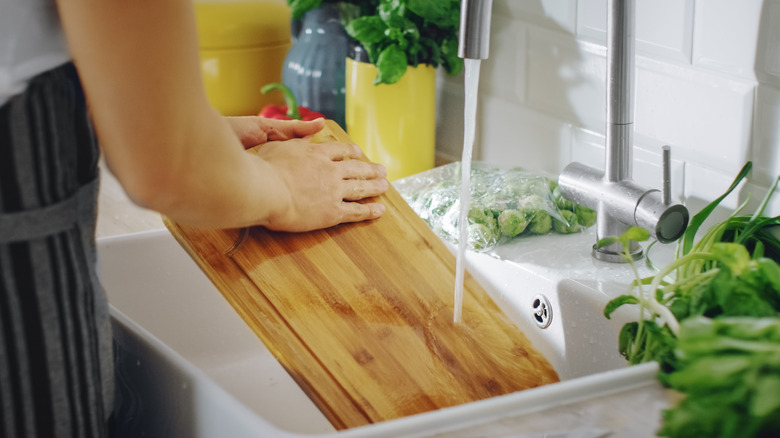Why You Should Be Flipping Wooden Cutting Boards After Every Use
Wooden cutting boards are a staple in many chef's kitchens. Aesthetically, they're pretty enough that they can be left out on the counter instead of stowed away in a cabinet or drawer, and with proper care, they can last a very long time.
Wooden cutting boards may seem intimidating at first, especially when you start reading about the care and cleaning that goes into keeping your cutting board free from bacteria. In reality, though, wooden cutting boards are easier to care for than it seems, as long as you follow the right techniques. Think of your wooden cutting board as you would a cast iron skillet: both require specific cleaning regimens and often need regular upkeep, but with the proper care, their longevity and quality are worth it.
A major technique for prolonging the life of your wooden cutting board is being strategic about wear and tear. Specifically, flip the cutting board regularly so that both sides get even use.
Flipping cutting boards for longevity
Flipping the wooden cutting board regularly ensures that no one side is considered the "top." This has a number of benefits when it comes to managing wear and tear. First and perhaps most obvious, when you use two sides instead of one, you essentially double the life of your cutting board. "We purposely don't put feet on our boards because we want you to flip it," Tanya Reazor, founder of cutting board company Fifth & Cherry says (via Clean Eating). "Flip it, and it'll last longer; it can be handed down and refinished."
When chefs do not flip the board and continue to use only one side, the cutting board not only becomes scratched and worn down twice as fast, but it also may sustain some damage from improper cleaning. Think about hand washing dishes — most people naturally spend more time scrubbing and rinsing the side of the dish that was used, whether it's a plate, a pan, or a cookie sheet. While that technique is usually fine for most dishes, it can cause warping in a wooden cutting board. The water causes wood to swell, and if only one side is consistently being washed, the wood will start to swell unevenly, which can lead to a cutting board resting unevenly on a flat surface, or a board that even rocks as you try to use it. To prevent this, make sure to wash the entire cutting board every time, regardless of which side you used.
Other ways to prolong the life of your wooden cutting board
Aside from regular flipping, there are a few other techniques that can extend the life of your wooden cutting board. The first is proper cleaning. Wooden cutting boards should never be placed in a dishwasher or left to soak in a sink full of water, since prolonged exposure to water and heat can cause the wood to warp and crack. Wooden cutting boards should be handwashed with warm water and dish soap, making sure to get all sides and edges. For stubborn stains, apply a mixture of coarse salt and lemon juice, let it sit for a few minutes, then scrub and rinse. Once the board is clean, immediately wipe it dry with a dish towel or paper towel and sit it upright on its side to air dry completely, ensuring both surfaces are exposed.
In addition to proper cleaning, regular conditioning is important to keep the wood from wearing down. It can also prevent it from harboring germs and bacteria. About once a month, condition your wooden cutting boards with oil and wax. Since cooking oil like vegetable and olive oil can go rancid over time, many recommend using mineral oil for conditioning. Simply apply a thin, even layer of oil to all surfaces of a clean, dry cutting board and let it absorb for a few hours. Then, seal the moisture in with a cutting board wax or cream. Like the oil, apply a thin, even layer all over the board, then let it dry overnight, and buff it in the morning with a microfiber cloth. This should create a smooth, sealed surface that repels water and moisture.


